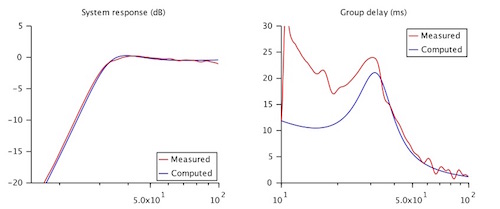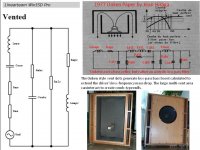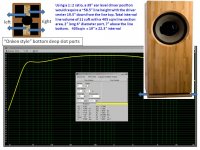Dear all,
I have developed scilab scripts to optimise my ONKEN enclosures. I write a paper on this topic which can be downloaded here.
These scripts are used to identify vented-box parameters from impedance measurements : enclosure losses (port Qp, leakage Ql, and absorption losses Qa), the system tuning ratio h and the system compliance ratio alpha.
Additionally, these scripts calculate the free-field frequency response based on measurement of the acoustical pressure within the enclosure.
The following figure shows the computed and measured system frequency response.

The simulated response is very consistant with the measured response.
Comments are welcome.
Jean Fourcade
Toulouse
I have developed scilab scripts to optimise my ONKEN enclosures. I write a paper on this topic which can be downloaded here.
These scripts are used to identify vented-box parameters from impedance measurements : enclosure losses (port Qp, leakage Ql, and absorption losses Qa), the system tuning ratio h and the system compliance ratio alpha.
Additionally, these scripts calculate the free-field frequency response based on measurement of the acoustical pressure within the enclosure.
The following figure shows the computed and measured system frequency response.

The simulated response is very consistant with the measured response.
Comments are welcome.
Jean Fourcade
Toulouse
Genius Designer Jean Hiraga's Altec 604E speaker uses a down-firing port that is slot-loaded into the integral base plinth.
Jean’s description sounds like Onken type narrow slot ports(low frequency filters) that exit around the bottom perimeter on 2 or 3 sides. The bottom rear is sealed.
Jean Hiagra
"The chosen solution here accepts a load of much smaller speaker volume (around 190 liters, instead of the usual 350 liters required for a 15 in. woofer) without experiencing a sharp decrease in sensitivity over the low frequencies, none of the usual sound colorations when a large woofer is associated with a load of small volume. This goal has been reached successfully thanks to the merging of several means : no back-chamber/throat (decompression) but a tuned load (BR) thanks to a laminar vent situated under the speaker itself, to adequate filters and, finally, proper internal padding on wooden walls made of an optimized sandwich of plies.”
With tools like WinISD and Transmission line Simulator, the subtle difference between a "MLTL termination port", “ reflex ports” and a “low pass filter” cannot be accurately modeled. I hope your research will aid my education.
Jean’s description sounds like Onken type narrow slot ports(low frequency filters) that exit around the bottom perimeter on 2 or 3 sides. The bottom rear is sealed.
Jean Hiagra
"The chosen solution here accepts a load of much smaller speaker volume (around 190 liters, instead of the usual 350 liters required for a 15 in. woofer) without experiencing a sharp decrease in sensitivity over the low frequencies, none of the usual sound colorations when a large woofer is associated with a load of small volume. This goal has been reached successfully thanks to the merging of several means : no back-chamber/throat (decompression) but a tuned load (BR) thanks to a laminar vent situated under the speaker itself, to adequate filters and, finally, proper internal padding on wooden walls made of an optimized sandwich of plies.”
With tools like WinISD and Transmission line Simulator, the subtle difference between a "MLTL termination port", “ reflex ports” and a “low pass filter” cannot be accurately modeled. I hope your research will aid my education.
Attachments
Nicely done article Jean!
I'm digesting it...
Linesource, Hiraga's "circuit" and text look more like flim-flam than anything real. Perhaps poor translation...
I'm digesting it...
Linesource, Hiraga's "circuit" and text look more like flim-flam than anything real. Perhaps poor translation...
Jean, Interesting article. P3 -'the internal volume Vb can be adjusted' - not sure how practical this is, when the alternative is to change the port tuning (not quite the same result, I know). And history tells us that the approach of using scripts in a relatively obscure program won't necessarily lead to widespread use of this method. A famous designer took his bat & ball & went home after this approach wasn't widely adopted. People are lazy, and a stand-alone program with a simple GUI is far more acceptable to most. So, perhaps a clever programmer can be of help here, It would be good to see an alternative to the usual approach, specially because your method gets around the problematic Vas measurement.
Ron, Linesource, re:'Perhaps poor translation... ' - even with my poor schoolboy French, the caption "Onken is not a bass reflex..." in Hiraga's original 1977 article is more accurately 'This equivalent circuit is in effect a dampened low pass filter and not a resonant circuit" (&I doubt that that is an accurate statement) If the claim had any validity, it could be supported by an impedance plot; none is given in Hiraga's article. Linesource's graph looks like an EBS alignment. The claim 'the chosen solution here accepts a much smaller speaker volume' doesn't appear in that paper, perhaps you have another reference for this Linesource? Anyway, all this Onken stuff is OT
Last edited:
Hiraga's paper here (In French) give impedance graphs, & notes the smaller volume is a compromise:
La petite Onken (J.Hiraga)
La petite Onken (J.Hiraga)
Audiophile magazine gave blueprints of three different enclosures called Onken. Two of them was designed by Koizumi the founder of Onken.
The first one was written in 1977 by Jean Hiraga. It describes what we can call the original Onken enclosure which uses an Altec 416-8a (see here).
In this article it is true that Hiraga states that the Onken enclosure is not a bass reflex but a dampened low pass filter.
The second one was also written by Hiraga in 1982 and describes what is called "la petite Onken". This enclosure use an Altec 414. In this article, Hiraga dont speak anymore of dampened low pass filter. There are some formulas given by Koisumi but which differ from those of Small. Some are missing because Koizumi wants to keep them secrets and it is impossible to understand how this enclosure was modeled.
The last one was written in 1982 by Jacques Mahul, who founded the Focal entreprise. This article describes what is called the «mini-oaken» (link). This enclosure uses the 10C01 Focal loudspeaker.
In this article Jacques Mahul has study the «petite Onken» and found that it can be considered as a vented-box following Snyder alignement with Vb/Vas.Qts^2 = 6.34. The mini-onken was designed the same way.
One must be remembered that the original Onken enclosure was designed by Koizumi in 1965. It was before the work of Thielle and Small on vented-enclosures which take place in the early 1970. It was therefore not surprising that the modeling differs.
The claim "the chosen solution here accepts a much smaller speaker volume" comes from another enclosure designed by Jean-Hiraga this time which uses an Altec 604E.
The text :
"The chosen solution here accepts a load of much smaller speaker volume (around 190 liters, instead of the usual 350 liters required for a 15 in. woofer) without experiencing a sharp decrease in sensitivity over the low frequencies, none of the usual sound colorations when a large woofer is associated with a load of small volume. This goal has been reached successfully thanks to the merging of several means : no back-chamber/throat (decompression) but a tuned load (BR) thanks to a laminar vent situated under the speaker itself, to adequate filters and, finally, proper internal padding on wooden walls made of an optimized sandwich of plies.*"
is the translation of the french text which advertises this enclosure :
"La solution choisie ici adopte des charges de volume beaucoup plus réduit, proche de 190 litres seulement, sans que ces systèmes souffrent pour autant ni d’une baisse importante de sensibilité dans le registre de grave, ni de colorations diverses se produisant lorsqu’un haut-parleur de gros diamètre est associé* une charge de petit volume. Cet objectif a pu être atteint grace à la synergie de
divers moyens : charge décompressé, mais accordée, grâce à un évent laminaire périphérique inférieur, à des filtres et traitements mécanico-acoustiques internes et à des parois de structure sandwich optimisées. Ces solutions combinées permettent d'atteindre l'objectif recherché, le haut rendement avec toutes ses qualités et sans ses inconvénients."
This is more like commercial arguments than technical ones. This does not really describe how this enclosure is designed. It seems that this enclosure use resistive-vent.
The first one was written in 1977 by Jean Hiraga. It describes what we can call the original Onken enclosure which uses an Altec 416-8a (see here).
In this article it is true that Hiraga states that the Onken enclosure is not a bass reflex but a dampened low pass filter.
The second one was also written by Hiraga in 1982 and describes what is called "la petite Onken". This enclosure use an Altec 414. In this article, Hiraga dont speak anymore of dampened low pass filter. There are some formulas given by Koisumi but which differ from those of Small. Some are missing because Koizumi wants to keep them secrets and it is impossible to understand how this enclosure was modeled.
The last one was written in 1982 by Jacques Mahul, who founded the Focal entreprise. This article describes what is called the «mini-oaken» (link). This enclosure uses the 10C01 Focal loudspeaker.
In this article Jacques Mahul has study the «petite Onken» and found that it can be considered as a vented-box following Snyder alignement with Vb/Vas.Qts^2 = 6.34. The mini-onken was designed the same way.
One must be remembered that the original Onken enclosure was designed by Koizumi in 1965. It was before the work of Thielle and Small on vented-enclosures which take place in the early 1970. It was therefore not surprising that the modeling differs.
The claim "the chosen solution here accepts a much smaller speaker volume" comes from another enclosure designed by Jean-Hiraga this time which uses an Altec 604E.
The text :
"The chosen solution here accepts a load of much smaller speaker volume (around 190 liters, instead of the usual 350 liters required for a 15 in. woofer) without experiencing a sharp decrease in sensitivity over the low frequencies, none of the usual sound colorations when a large woofer is associated with a load of small volume. This goal has been reached successfully thanks to the merging of several means : no back-chamber/throat (decompression) but a tuned load (BR) thanks to a laminar vent situated under the speaker itself, to adequate filters and, finally, proper internal padding on wooden walls made of an optimized sandwich of plies.*"
is the translation of the french text which advertises this enclosure :
"La solution choisie ici adopte des charges de volume beaucoup plus réduit, proche de 190 litres seulement, sans que ces systèmes souffrent pour autant ni d’une baisse importante de sensibilité dans le registre de grave, ni de colorations diverses se produisant lorsqu’un haut-parleur de gros diamètre est associé* une charge de petit volume. Cet objectif a pu être atteint grace à la synergie de
divers moyens : charge décompressé, mais accordée, grâce à un évent laminaire périphérique inférieur, à des filtres et traitements mécanico-acoustiques internes et à des parois de structure sandwich optimisées. Ces solutions combinées permettent d'atteindre l'objectif recherché, le haut rendement avec toutes ses qualités et sans ses inconvénients."
This is more like commercial arguments than technical ones. This does not really describe how this enclosure is designed. It seems that this enclosure use resistive-vent.
Last edited:
Pete, I agree that in practice the internal volume has not to be adjusted and that port tuning is enough to get the desired frequency response. My goal was simply to show that it is possible and that the target value of the the system compliance ratio can be reach if necessary.
Concerning scilab, I fully agree with you that stand-alone program with a simple GUI is far more acceptable. But my goal was just testing the method works and optimize my Onken. For that, scilab was the perfect candidate.
Concerning scilab, I fully agree with you that stand-alone program with a simple GUI is far more acceptable. But my goal was just testing the method works and optimize my Onken. For that, scilab was the perfect candidate.
Jean,
I tried to look at the linked pdf but the link is not working. I would very much like to read it.
S
I tried to look at the linked pdf but the link is not working. I would very much like to read it.
S
Hi swak,
It is strange because I have no problem to access to the pdf file.
Anyway, send me a personal message to give me an e-mail address, and I will send you directly the pdf file.
Jean
It is strange because I have no problem to access to the pdf file.
Anyway, send me a personal message to give me an e-mail address, and I will send you directly the pdf file.
Jean
Hi Jean, I tried the link and it worked perfectly, i don't know what the problem was when I tried last time.
I will be looking at the paper now. My plan is to start building boxes for the GPA 416-8B, and I think I will build the onken and other boxes to compare them. One thing that interests me is to build a smaller box (closes or vented) and play with stuffing/resistance in vents to lower the impedance peak down to a point where one can call it an aperiodic enclosure. Other than the very important advantage in size reduction I want to compare subjectively the bass quality. If there is some advantage at the cost of extension I would evaluate to use a complementary sub.
I will be looking at the paper now. My plan is to start building boxes for the GPA 416-8B, and I think I will build the onken and other boxes to compare them. One thing that interests me is to build a smaller box (closes or vented) and play with stuffing/resistance in vents to lower the impedance peak down to a point where one can call it an aperiodic enclosure. Other than the very important advantage in size reduction I want to compare subjectively the bass quality. If there is some advantage at the cost of extension I would evaluate to use a complementary sub.
Dear all,
I have developed scilab scripts to optimise my ONKEN enclosures. I write a paper on this topic which can be downloaded here.
These scripts are used to identify vented-box parameters from impedance measurements : enclosure losses (port Qp, leakage Ql, and absorption losses Qa), the system tuning ratio h and the system compliance ratio alpha.
Additionally, these scripts calculate the free-field frequency response based on measurement of the acoustical pressure within the enclosure.
The following figure shows the computed and measured system frequency response.
The simulated response is very consistant with the measured response.
Comments are welcome.
Jean Fourcade
Toulouse
I've been looking for this exact work for a long time, thank you!
Was this published in the AES?
This page has a spreadsheet (calculate-ql.xlsx) but it is not as comprehensive:
Bass reflex alignments explained - Step by step | Audio Judgement
Bass reflex alignments explained - Step by step | Audio Judgement
- Status
- Not open for further replies.
- Home
- Loudspeakers
- Multi-Way
- Least squares estimation of vented-box parameters Qa,Qp,Ql,h,alpha


